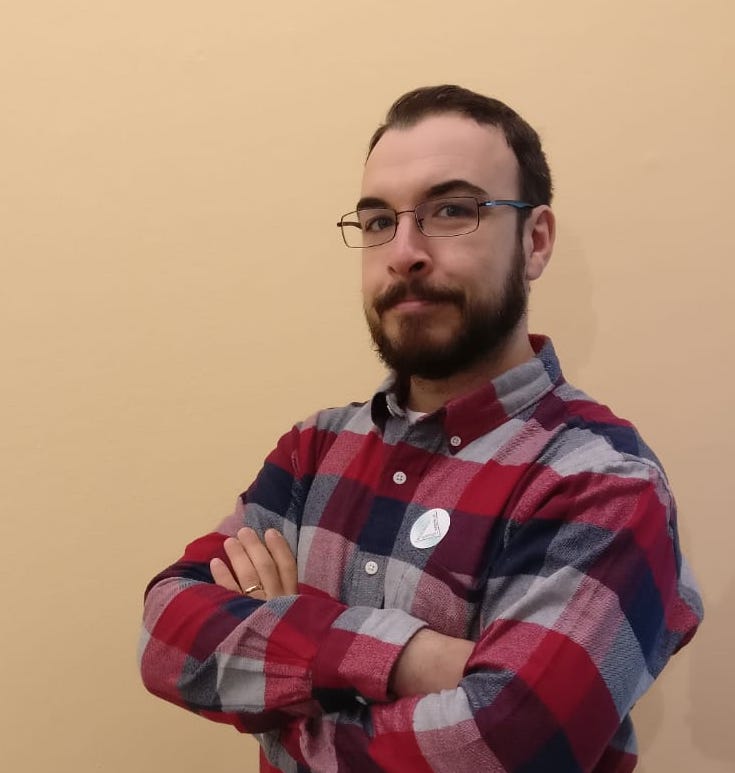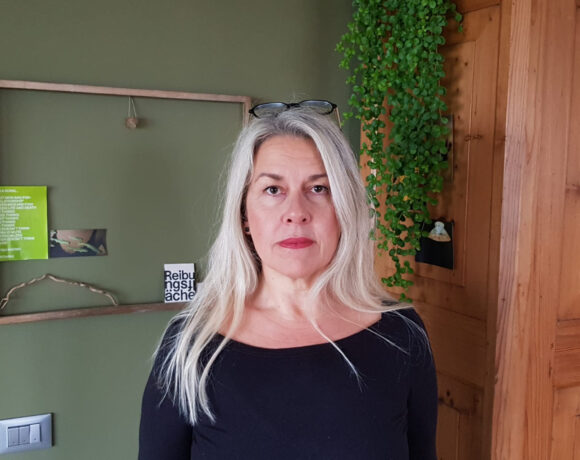Luca Beatrice is curator, critic, teacher and fan of Juventus. I had the opportunity to interview him on the occasion of the group exhibition that he curated, entitled VOLTI, currently running until 12 November 2023. Here the Italian portrait painting in the twentieth century, is set up in two exhibition venues, the Spazio Circolo in Bellano (Lecco) and Villa del Balbianello, heritage of the Fondo Ambiente Italiano in Tremezzina (Como).

Luca Beatrice
I would like to make the public understand who you are, but I would not want to summarize it myself, I would prefer that you do it describing yourself with the title of a work of art.
I’m not sure how to answer that. I am a 60-year-old man with four children, who likes to ride a motorcycle, who does not give up going to the stadium to see Juve play and who would have liked to travel a little more. I love what I do and, above all, I like to differentiate investments. I really like to continue going to school, in fact I teach both in the Academy and in two universities. As I am, I let others say it. Some people like me, others don’t like me. As I got older, I managed to overcome someone’s reluctance. But if I had to choose a work of art to describe myself, it would probably be the portrait of Mick Jagger made by Andy Warhol. The frontman of the Rolling Stones has just turned eighty: I would like to get to that age with his energy.
Is there an exhibition, a project, an idea that he would like to realize, but has not yet realized?
Yes, there are several, although fortunately I was able to make almost all the exhibitions that I have set out or that have asked me to do – I always prefer to work on commission – and I will make a couple next year, one of which I particularly care about.

VOLTI, Veduta della mostra, Spazio Circolo, Bellano – Villa del Balbianello, Tremezzina, 2023. Ph. Carlo Borlenghi
What are your main goals when curating art exhibitions? What do you hope the public will get from this experience?
My profession is rather fragmented. On the one hand I teach, on the other I curate exhibitions and on the other, as a journalist, I write about exhibitions curated by other people. What do I expect from the exhibition VOLTI. Italian portrait painting in the 20th century? To solicit the interest of the public especially on the topics dealt with: making an exhibition you get something from the cultural point of view? I hope so, yes. Today we are used to saying: “There is little concentration, the threshold of attention is low, we are all in a hurry, only Instagram friendly art counts”. I am from another generation, I come from a completely different world. What I could not do is adapt my language, which I have been carrying on for almost forty years, to the desires of my time. So I still hope that an exhibition like this, with a traditional approach, can be appreciated by the public.
In your opinion, should the audience be trained or be entertained in an art exhibition?
The word “entertainment”, linked to art, does not make me crazy. We have this habit of wanting to be entertained: we stay at home and while we enjoy a movie we keep the smartphone on the sofa, we can not take our eyes off the screen, we check if a message has arrived or if someone has posted something interesting on Instagram. Art and culture would require a greater effort: to watch a film takes a couple of hours, a book takes a few days, while to enjoy a work of art it seems enough to pass by and leave. However, those interested in art and culture must consider a greater commitment.

VOLTI, Veduta della mostra, Spazio Circolo, Bellano – Villa del Balbianello, Tremezzina, 2023. Ph. Carlo Borlenghi
Can you tell us how your curatorial choices are born?
Coincidentally. In the nineties, in my twenties and thirties, I believed, like everyone in my generation, in a militant criticism hypothesis. We came from experiences like Arte Povera and Transavanguardia, so we all wanted to form our group. For example, Gabriele Perretta invented Medialism, after which everyone wanted to be media or medialistic and those who were not were excluded. We also wanted to build our stable, our group, our reference artists. But this happened in a local reality, when artists from Milan and Turin had never exhibited in Naples or Rome. Things then changed and my generation was the hinge between an old local society and the new global society, in which probably it makes no sense to talk about “Italian art”, so much so that in the great international exhibitions you do not see Italian artists, such as the last edition of Documenta. Today, even for young people, it is much more interesting to go and find answers to their questions in an international context. Even I, who have a certain age, thought that my militancy could focus on history: the seventies, the eighties, the nineties are already to some extent “history”. I don’t make militant criticism choices today. Maybe I find a young painter I like and I’m interested in, such as Davide Serpetti, and invite him to exhibitions. But the militancy and the curatorial choices I leave to others, and it seems right so.
Is there a physical place or in your memory that you can identify as the beginning of your journey and work?
Actually there are several of them. I was born, I grew up and I studied in Turin, and then I attended the graduate school in Siena. That was a decisive moment, because Siena was my first chance to understand what contemporary art could be. At the time – I was talking about the second half of the eighties – I had no idea. The meeting with Enrico Crispolti, teacher and director of the School, was decisive. I lived several years in Rome, I went back to Turin and I commuted to Milan. So there are many places. In this regard, on September 12 a new book of mine will be published dedicated to this sort of “cartography of the heart” that crosses places and meetings. The meetings, in fact, were functional to the places: where I met interesting people, I then linked to the place. I have a great relationship with the province, after all I consider myself a person of the province and right now I’m in Pietrasanta, Versilia, another of the places I love very much.

VOLTI, Veduta della mostra, Spazio Circolo, Bellano – Villa del Balbianello, Tremezzina, 2023. Ph. Carlo Borlenghi
What does he find – if anything – interesting in the so-called blockbuster exhibitions?
I’ve made some blockbuster exhibitions. However, I think the term should now be deleted and replaced with something more appropriate. I have curated and co-curated several such exhibitions, such as those dedicated to Pollock, the Irascibles, Warhol, the Pre-Raphaelite. The important thing is to show works that are such, do not promise things that you can not achieve, maintaining a scientific in what you are doing.
What would you recommend to a young person who wants to take this career path?
I would recommend to study a lot, to train well at university, to have cultural curiosity starting from other artistic forms such as literature, theater, cinema, to feel part of a community. And, if I may add something more prosaic, get paid from the first moment you lift your pen or put your hands on the keyboard, because when you call the plumber or when you go to buy bread, you pay them: it is right that intellectual work is also respected.

VOLTI, Veduta della mostra, Spazio Circolo, Bellano – Villa del Balbianello, Tremezzina, 2023. Ph. Carlo Borlenghi
Do you think art can influence the way people think and see the world?
No, art is a category of thought in itself. He has the possibility to arrive first to certain intuitions because – not having to prove anything – it can be utopia, dream, imagination. Unlike architecture, which designs a building that must then stand on its feet, art has this extra possibility: it can bypass reality and imagine worlds and visions.
How do you assess the importance of dissemination and artistic education to involve the public in exhibitions?
If we’re talking about art education, the first thing that comes to mind is school. On my identity card it says “teacher”, not “art critic”, which, moreover, is a professional category that does not exist. School is the first place of formation, from childhood to university, even before the so-called “popularization”. The school must be the place where artistic culture is made from the beginning. Two years ago I tried to write about contemporary art for middle school: this was a great gym, because you have to understand what is usually explained to university students, to classes of boys who enter children and leave adolescents, with very different languages and knowledge.

VOLTI, Veduta della mostra, Spazio Circolo, Bellano – Villa del Balbianello, Tremezzina, 2023. Ph. Carlo Borlenghi
If you didn’t do what you do, what would you like to do?
What I did comes from a series of failures. When I was a kid, I wanted to be a Juventus goalkeeper, a motorcycle racer or a singer in Sanremo. I didn’t do any of that, but there was one thing I liked doing: the school paper. The idea of writing has always chased me, since elementary school. Some artists say: “I’ve been painting since I was a child”. I don’t – I’m not capable of it – but I’ve always liked writing. I can’t tell a story, but watching and describing reality is good for me. This, perhaps, has more to do with art than literature. Among the many jobs I do, considering that teaching is perhaps the one where civic duty is most felt, I wouldn’t change writing for anything else. If I hadn’t been an art critic, I might have been a full-time journalist.
If you could choose a character, historical or fantasy, to be included in your work team, who would you choose?
I don’t know how to answer because in my team there are always very young people, former students of whom I realized that there was “fat” and with whom I started working. I love to surround myself with people much younger than me, who are better, more patient, more punctual, more attentive. My satisfaction is also to see them go away and change course. Besides, I wouldn’t want a more important historical figure on my team, because I’m the star.
Francesco Liggieri
Info:
VOLTI. Italian portrait painting in the 20th century
Curated by Luca Beatrice, conceived by Velasco Vitali and produced by ArchiViVitali
21/07 – 12/11/2023
Spazio Circolo (Bellano) and Villa del Balbianello (Tremezzina, Como)

Independent artist and curator. Founder of No Title Gallery in 2011. I observe, study, ask questions, take informations and live in contemporary art, a real stimulus for my research.






NO COMMENT